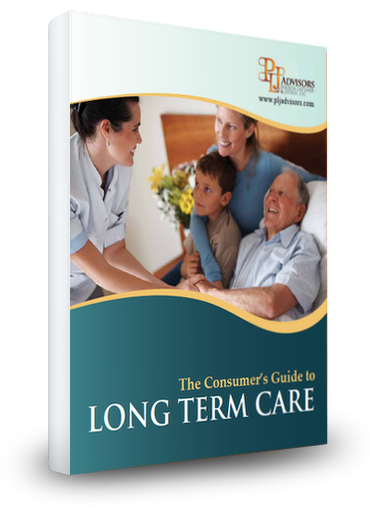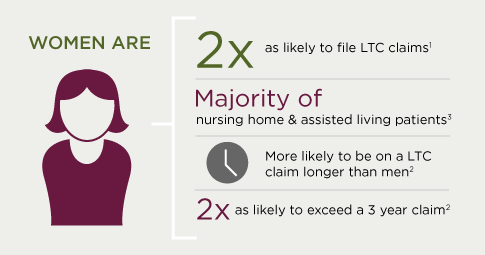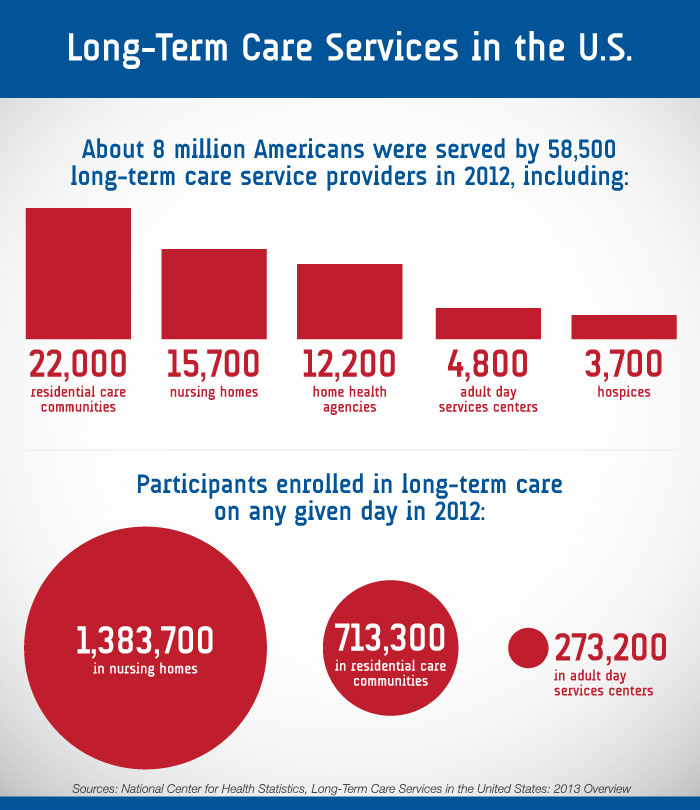 The Consumer’s Guide to Long-Term Care was developed for people concerned about how to plan, provide, and pay for longterm care for themselves, a spouse, parent, or loved one. It contains information to help you make decisions now and in the years to come that will allow you to retain more control of your life if you need long-term care. We suggest that you share the guide with your family and friends, using the information to begin discussing your long-term care needs and financial options before a crisis arises.
The Consumer’s Guide to Long-Term Care was developed for people concerned about how to plan, provide, and pay for longterm care for themselves, a spouse, parent, or loved one. It contains information to help you make decisions now and in the years to come that will allow you to retain more control of your life if you need long-term care. We suggest that you share the guide with your family and friends, using the information to begin discussing your long-term care needs and financial options before a crisis arises.
Everyone’s situation is unique. Your decisions and those of your family members — about what type of retirement you want or where you will live when you are older—depend on your individual values, desires, and financial circumstances. The best long-term care option for you may be different from the one chosen by another family member or friend.
The Consumer’s Guide to Long-Term Care was developed for people concerned about how to plan, provide, and pay for longterm care for themselves, a spouse, parent, or loved one. It contains information to help you make decisions now and in the years to come that will allow you to retain more control of your life if you need long-term care. We suggest that you share the guide with your family and friends, using the information to begin discussing your long-term care needs and financial options before a crisis arises.
Everyone’s situation is unique. Your decisions and those of your family members — about what type of retirement you want or where you will live when you are older—depend on your individual values, desires, and financial circumstances. The best long-term care option for you may be different from the one chosen by another family member or friend.
Understanding Long-Term Care
Martha has always been a saver. She planned for emergencies. She thought Medicare would pay most of her medical costs; she even purchased a Medicare supplemental policy to limit how much she would have to pay out of her own funds. Now, she has learned that in her case, Medicare will only pay for the first 35 days of her stay in the nursing home. Apparently, there’s a rule about needing to receive therapy every day, not just once or twice a week. Now she will have to pay the nursing home expenses herself, and her savings could be used up very quickly. And then, what would she do?
Most of us would like to be able to look into a crystal ball to see what our lives will be like ten, twenty or thirty years from now. Will we be healthy or will we need care and assistance from others? If we need help, will we be able to live at home? Will we spend some time in a nursing home, like Martha? Will we need long-term care?
Note: Medicare only pays for nursing home care if there is a prior qualifying hospital stay of at least three days and skilled nursing or rehabilitative care is needed every day. In some cases a HMO enrollee may not have to meet the three-day hospital requirement, but will have to meet the need for skilled nursing or rehabilitative care. In any event, the Medicare benefit for nursing home care will only last for a maximum of 100 days and, in most cases, for far fewer days.
What Is Long-Term Care?
Long-term care is the kind of help you require for taking care of your personal needs, such as bathing, dressing, eating, continence, toileting, and transferring. These needs are commonly referred to as Activities of Daily Living or ADLs. You might need this kind of help because of a chronic medical or physical condition like Martha had. Frequently, people with Alzheimer’s disease or other health conditions may need ongoing supervision as well because of cognitive impairment. People who can no longer drive, manage their medications, or their finances often need help with these “instrumental activities” before they will need or qualify for formal long-term care services. Long-term care covers a broad range of needs and services. Services to meet those needs include care at home or in a community program like adult day care, as well as assisted living or nursing home care.
Will I Need Long-Term Care Services As I Get Older?
Anyone at any age may need long-term care. An accident or a sudden, serious illness can create a need for care, as can the slow progression of chronic diseases such as rheumatoid arthritis, Alzheimer’s disease, or Parkinson’s disease. The senior population is increasing and age or frailty may also be contributing factors, as show in Charts #1 (6-1, More Frail Elderly, More Care Needed Projected Number of Californians, Age 85 and Older, 1990-2030) and #2 (6-2, Ages of Residents of California Freestanding Nursing Homes, 2005). People who live to be very old are more likely to need long-term care than those at younger ages. In addition to age and disability, there are other factors that can affect the need for long-term care.
Marital Status

¹ The 2014 Sourcebook for Long-term Care Insurance Information — AALTCI 2014.
² U.S. Department of Health and Human Services, Longtermcare.gov, 2013.
³ U.S. Department of Health and Human Services, National Clearinghouse for Long-term Care Information, 2013
Traditionally, women have married men who are older. Since women also live longer, many eventually outlive their husbands. It is not unusual to find an older man being cared for by his younger wife. When a woman needs long-term care services, she is often widowed and living alone. A daughter or daughter-in-law often provides care to a family member who lives at home. But frequently a widowed spouse needs more care than family members can provide at home and will eventually receive longterm care in a nursing home. According to a 2002 national study, from 1992 to 1998 there was a significant increase in the proportion of women in nursing homes who were widowed, separated, or divorced. And, married people are half as likely as unmarried persons to be admitted to a nursing home, further illustrating the difficulty of providing continuous care at home to a single or widowed family member.
Functional Limitations
Women develop chronic diseases, such as arthritis and osteoporosis, more often than men. These diseases limit the ability to walk, get in and out of a chair, and to do other tasks of daily life. Men are more likely to have acute health episodes that lead to earlier and quicker death, and shorten the length of time a man is likely to need long-term care. However, when thinking about long-term care, you should remember that these are generalizations and your situation may be different.
Family Circumstances and Support Systems
Whether a person can remain at home once they begin to need care often depends on their support system. Many older people do not live near their families, and their support system may consist of neighbors and friends who may not always be available. If an older person does live near their family, family caregivers may work full time or be unable to offer as much help as is needed. Family members, however, do provide significant amounts of unpaid long-term care. Many middle-aged women find themselves sandwiched between the needs of their school are children and family responsibilities, their jobs, and the needs of an older family member who has cognitive or functional limitations.
What can I do to reduce my chance of needing Long-Term Care?
Some of us will need help as we get older; no matter how well we take care of ourselves. Diseases such as arthritis and osteoporosis can affect our ability to get around and may lead to dependence on other people. Debilitating accidents can occur at any time, and advanced age is often accompanied by increased frailty. However, recent research demonstrates that we are more in control of our own aging than previously assumed.
Good nutrition and regular exercise have been shown to be the key ingredients to a healthy and active old age. And the earlier we get started, the better. High fiber, low-fat diets decrease the incidence of cancer, heart disease, and many other “modern” ailments as well. And exercise may be equally as important as nutrition in helping us to remain active throughout our lifetime.
Although our muscles get smaller in size as we age, weak muscles are not a normal part of aging. Older people who exercise have less deterioration in muscle tone. Walking, combined with moderate stretching exercises to retain flexibility, is by far the best exercise. Although illness or injury can affect the muscles and joints, with good medical treatment even this damage can be greatly reduced. However, there is no magic ingredient that allows us to stay it. It takes determination, discipline, belief that good nutrition and exercise are worth the effort, along with a little bit of luck!
Of course, there are some things we cannot control. Alzheimer’s and similar diseases that affect how our brain and nervous system work often lead to the need for long-term care. Over half of nursing home residents have a cognitive disorder like Alzheimer’s disease. Not only is this a devastating condition for patients and their families, but there is also no known cure at the present time.
Planning for Long-term Care
What Options Are Available To Me At Home If I Need Care?
Formal paid services include:
- Home Health Care: from a nurse or other licensed personnel;
- Personal Care: help with bathing, grooming, getting from a chair to a bed, and other personal assistance;
- Homemaker Services: housekeeping, cooking and grocery shopping;
- Hospice Care: support for patients with terminal illnesses and their families;
- Respite Care: temporary relief for caregivers;
- Adult Day Programs: formerly known as Adult Day Care, these community-based programs provide individualized day care in a protective setting to persons 18 years of age or older who need personal care services, supervision, or assistance with ADLs;
- Adult Day Health Care: day care that provides medical, rehabilitative and social services through an individualized plan of care to persons 18 years of age or older with functional limitations caused by physical or mental impairment; and
- Alzheimer’s Day Care Resource Centers: individualized day care for people with moderate to late stage Alzheimer’s disease or related dementias.
Many people who use home care services may also be receiving additional help from their family or friends. When someone needs this additional support and it isn’t available, they may not be able to stay in their own home. One option is to move to a place that combines housing and the services a person needs. Some living arrangements provide room and board and personal care (help with ADLs, grooming, medications, and light housekeeping) in a supervised setting. These services may be provided in an assisted living facility; or if a higher level of care is needed, the individual may need to move to a Skilled Nursing Facility (nursing home). These facilities are discussed later in this guide.

Will Medicare Pay For Long-Term Care In A Nursing Home?
Most long-term care delivered in nursing homes is provided to people with chronic, long-term illnesses or disabilities. The care they receive is personal care, sometimes still referred to as custodial care. Medicare does not pay for this kind of care. It pays less than 10 percent of all nursing home costs. Medicare only pays when you are receiving medical and rehabilitative care, and then only for a set period of time. To qualify for the limited Medicare nursing home benefit, you must first have spent three full days in a hospital within 30 days of your admission to a nursing home. You must also need skilled care that only a license professional can provide, every day of your stay. If you meet these requirements Medicare will only pay the full cost of nursing home care up to the first 20 days of a covered stay. After the first 20 days, if you still require daily skilled care, Medicare will pay part of the nursing home bill. You will have to pay a co-payment ($119 in 2006) for each day of the next 80 days that Medicare continues to pay for your stay. Medicare will not continue to pay after is has paid for your nursing home care for 100 days within a benefit period.
Do Medicare HMOs Pay For Long-Term Care?
No. Some Health Maintenance Organizations (HMOs) and other Medicare Advantage plans have a contract with the federal government to provide Medicare covered services to Medicare beneficiaries. Members of these plans generally have no more coverage for long-term care than someone with traditional Medicare fee-for-service benefits. Medicare HMOs and other Medicare Advantage plans usually provide only those skilled nursing facility services and home health services that are covered by Medicare and meet the same requirements for skilled care. However, members of these plans may or may not have to pay co-payments for these services depending on the requirements of that person’s Medicare Advantage plan.


— One Comment —
Comments are closed.